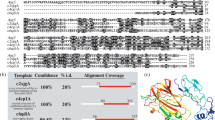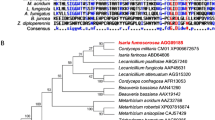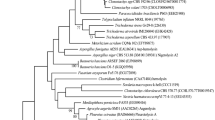Abstract
Adherence of conidia to insect integument is crucial for initiation of fungal infection through cuticular penetration and was previously reported to rely upon the Metarhizium-type adhesin Mad1 rather than Mad2, another adhesin crucial for conidial adherence of Metarhizium anisopliae to plant root surface. Mad1 and Mad2 have since been considered to function in fungal insect pathogenesis and plant root colonization respectively. Here, three adhesins were characterized in Beauveria bassiana, including Adh1/Mad1, Adh2/Mad2, and Adh3 known as filamentous hemagglutinin/adhesin and virulence factor in animal-pathogenic bacteria. Among those, only Adh2 was found to play a substantial role in sustaining the fungal virulence and some phenotypes associated with biological control potential. Disruption of adh2 resulted in decreased conidial adherence to insect wing cuticle, attenuated virulence via normal cuticle infection or cuticle-bypassing infection (injection), reduced blastospore production in an insect hemolymph-mimicking broth, largely reduced conidiation capacity, impaired conidial quality indicative of lowered viability, hydrophobicity, and UV resistance, but no growth defects on rich and scant media under normal or stressful culture conditions. The main phenotypic changes correlated well with repressed expression of developmental activator genes required for aerial conidiation and submerged blastospore production and of key hydrophobin genes essential for hydrophobin synthesis and assembly into rodlet bundles of conidial coat crucial for conidial adherence. In contrast, either adh1 or adh3 disruption caused insignificant changes in all phenotypes examined. These findings offer novel insight into a significance of Adh2, but a dispensability of Adh1 or Adh3, for insect-pathogenic lifecycle of B. bassiana.
Key points
• Three adhesins (Adh1–3) of Beauvera bassiana are functionally characterized.
• Adh2 plays a role in sustaining virulence and lifecycle-related cellular events.
• Either Adh1 or Adh3 is dispensable for insect-pathogenic lifecycle of B. bassiana.



Similar content being viewed by others
Data availability
All data generated or analyzed during this study are included in this published article (and its supplementary information files).
References
Abro NA, Wang GJ, Ullah H, Long GL, Hao K, Nong XQ, Cai N, Tu XB, Zhang ZH (2019) Influence of Metarhizium anisopliae (IMI330189) and Mad1 protein on enzymatic activities and Toll-related genes of migratory locust. Environ Sci Pollut Res 26:17797–17808
Barelli L, Padilla-Guerrero IE, Bidochka MJ (2011) Differential expression of insect and plant specific adhesin genes, Mad1 and Mad2, in Metarhizium robertsii. Fungal Biol 115:1174–1185
Bischoff JF, Rehner SA, Humber RA (2009) A multilocus phylogeny of the Metarhizium anisopliae lineage. Mycologia 101:512–530
Chen AH, Wang YL, Shao Y, Zhou QM, Chen SL, Wu YH, Chen HW, Liu EQ (2018) Genes involved in Beauveria bassiana infection to Galleria mellonella. Arch Microbiol 200:541–552
Chu ZJ, Sun HH, Zhu XG, Ying SH, Feng MG (2017) Discovery of a new intravacuolar protein required for the autophagy, development and virulence of Beauveria bassiana. Environ Microbiol 19:2806–2818
Danilchanka O, Sun J, Pavlenok M, Maueröder C, Speer A, Siroy A, Marrero J, Trujillo C, Mayhew DL, Doornbos KS, Muñoz LE, Herrmann M, Ehrt S, Berens C, Niederweis M (2014) An outer membrane channel protein of Mycobacterium tuberculosis with exotoxin activity. Proc Natl Acad Sci U S A 111:6750–6755
de Faria M, Wraight SP (2007) Mycoinsecticides and mycoacaricides: a comprehensive list with worldwide coverage and international classification of formulation types. Biol Control 43:237–256
Fang WG, Zhang YJ, Yang XY, Zheng XL, Duan H, Li Y, Pei Y (2004) Agrobacterium tumefaciens mediated transformation of Beauveria bassiana using an herbicide resistance gene as a selection marker. J Invertebr Pathol 85:18–24
Feng MG, Poprawski TJ, Khachatourians GG (1994) Production, formulation and application of the entomopathogenic fungus Beauveria bassiana for insect control: current status. Biocontrol Sci Tech 4:3–34
Gao BJ, Mou YN, Tong SM, Ying SH, Feng MG (2020) Subtilisin-like Pr1 proteases marking evolution of pathogenicity in a wide-spectrum insect pathogenic fungus. Virulence 11:365–380
Gao Q, ** K, Ying SH, Zhang YJ, **ao GH, Shang YF, Duan ZB, Hu X, **e XQ, Zhou G, Peng GX, Luo ZB, Huang W, Wang B, Fang WG, Wang SB, Zhong Y, Ma LJ, St Leger RJ, Zhao GP, Pei Y, Feng MG, **a YX, Wang CS (2011) Genome sequencing and comparative transcriptomics of the model entomopathogenic fungi Metarhizium anisopliae and M. acridum. PLoS Genet 7:e1001264
Holder DJ, Kirkland BH, Lewis MW, Keyhani NO (2007) Surface characteristics of the entomopathogenic fungus Beauveria (Cordyceps) bassiana. Microbiolo-SGM 153:3448–3457
Huang BF, Feng MG (2009) Comparative tolerances of various Beauveria bassiana isolates to UV-B irradiation with a description of a modeling method to assess lethal dose. Mycopathologia 168:145–152
Kulkarni RD, Kelkar HS, Dean RA (2003) An eight-cysteine-containing CFEM domain unique to a group of fungal membrane proteins. Trends Biochem Sci 28:118–121
Liu Q, Ying SH, Li JG, Tian CG, Feng MG (2013) Insight into the transcriptional regulation of Msn2 required for conidiation, multi-stress responses and virulence of two entomopathogenic fungi. Fungal Genet Biol 5:42–51
Livak KJ, Schmittgen TD (2001) Analysis of relative gene expression data using real-time quantitative PCR and the 2-ΔΔCT method. Methods 25:402–408
Montes-Garcia JF, Vaca S, Vazquez-Cruz C, Soriano-Vargas E, Aguilar-Romero F, Blackall PJ, Negrete-Abascal E (2016) Identification of a hemagglutinin from Gallibacterium anatis. Curr Microbiol 72:450–456
Mou YN, Gao BJ, Ren K, Tong SM, Ying SH, Feng MG (2020) P-type Na+/K+ ATPases essential and nonessential for cellular homeostasis and insect pathogenicity of Beauveria bassiana. Virulence 11:1415–1431
Nasser L, Weissman Z, Pinsky M, Amartely H, Dvir H, Kornitzer G (2016) Structural basis of haem-iron acquisition by fungal pathogens. Nat Microbiol 1:16156
Ortiz-Urquiza A, Keyhani NO (2013) Action on the surface: entomopathogenic fungi versus the insect cuticle. Insects 4:357–374
Ortiz-Urquiza A, Luo ZB, Keyhani NO (2015) Improving mycoinsecticides for insect biological control. Appl Microbiol Biotechnol 99:1057–1068
Peng GX, Tong SM, Zeng DY, **a YX, Feng MG (2020) Colony heating protects honey bee populations from a risk of contact with wide-spectrum Beauveria bassiana insecticides applied in the field. Pest Manag Sci 76:2627–2634
Roberts DW, St. Leger RJ (2004) Metarhizium spp., cosmopolitan insect-pathogenic fungi: mycological aspects. Adv Appl Microbiol 54:1–70
Shao W, Cai Q, Tong SM, Ying SH, Feng MG (2019) Rei1-like protein regulates nutritional metabolism and transport required for the asexual cycle in vitro and in vivo of a fungal insect pathogen. Environm Microbiol 21:2772–2786
Shang YF, **ao GH, Zheng P, Cen K, Zhan S, Wang CS (2016) Divergent and convergent evolution of fungal pathogenicity. Genome Bio Evol 8:1374–1387
Shang JM, Shang YF, Tang GR, Wang CS (2020) Identification of a key G-protein coupled receptor in mediating appressorium formation and fungal virulence against insects. Sci China Life Sci 64:466–477. https://doi.org/10.1007/s11427-020-1763-1
Shao W, Cai Q, Tong SM, Ying SH, Feng MG (2020) Nuclear Ssr4 is required for the in vitro and in vivo asexual cycles and global gene activity of Beauveria bassiana. mSystems 5:e00677–e00619
Sun J, Siroy A, Lokareddy RK, Speer A, Doornbos KS, Cingolani G, Niederweis M (2015) The tuberculosis necrotizing toxin kills macrophages by hydrolyzing NAD. Nat Struct Mol Biol 22:672–678
Sun YY, Chi H, Sun L (2016) Pseudomonas fluorescens filamentous hemagglutinin, an iron-regulated protein, is an important virulence factor that modulates bacterial pathogenicity. Front Microbiol 7:1320
Tong SM, Feng MG (2019) Insights into regulatory roles of MAPK-cascaded pathways in multiple stress responses and life cycles of insect and nematode mycopathogens. Appl Microbiol Biotechnol 103:577–587
Tong SM, Feng MG (2020) Phenotypic and molecular insights into heat tolerance of formulated cells as active ingredients of fungal insecticides. Appl Microbiol Biotechnol 104:5711–5724
Tong SM, Wang DY, Cai Q, Ying SH, Feng MG (2020) Opposite nuclear dynamics of two FRH-dominated frequency proteins orchestrate non-rhythmic conidiation of Beauveria bassiana. Cells 9:626
Tong SM, Gao BJ, Peng H, Feng MG (2021) Essential roles of two FRQ proteins (Frq1 and Frq2) in Beauveria bassiana’s virulence, infection cycle and calcofluor-specific signaling. Appl Environ Microbiol 87:e02545–e02520
Wang CS, St. Leger RJ (2007) The MAD1 adhesin of Metarhizium anisopliae links adhesion with blastospore production and virulence to insects, and the MAD2 adhesin enables attachment to plants. Eukaryot Cell 6:808–816
Wang CS, Feng MG (2014) Advances in fundamental and applied studies in China of fungal biocontrol agents for use against arthropod pests. Biol Control 68:129-135
Wang CS, Wang SB (2017) Insect pathogenic fungi: genomics, molecular interactions, and genetic improvements. Annu Rev Entomol 62:73–90
Wang DY, Ren K, Tong SM, Ying SH, Feng MG (2020) Pleiotropic effects of Ubi4, a polyubiquitin precursor required for ubiquitin accumulation, conidiation and pathogenicity of a fungal insect pathogen. Environ Microbiol 22:2564–2580
Wei QL, Du YR, ** K, **a YX (2017) The Ste12-like transcription factor MaSte12 is involved in pathogenicity by regulating the appressorium formation in the entomopathogenic fungus, Metarhizium acridum. Appl Microbiol Biotechnol 101:8571–8584
Wösten HAB (2001) Hydrophobins: multipurpose proteins. Annu Rev Microbiol 55:625–646
Wyrebek M, Bidochka MJ (2013) Variability in the insect and plant adhesins, Mad1 and Mad2, within the fungal genus Metarhizium suggest plant adaptation as an evolutionary force. PLoS One 8:e59357
**ao GH, Ying SH, Zheng P, Wang ZL, Zhang SW, **e XQ, Shang YF, Zheng HJ, Zhou Y, St Leger RJ, Zhao GP, Wang CS, Feng MG (2012) Genomic perspectives on the evolution of fungal entomopathogenicity in Beauveria bassiana. Sci Rep 2:483
Yao SL, Ying SH, Feng MG, Hatting JL (2010) In vitro and in vivo responses of fungal biocontrol agents to the gradient doses of UV-B and UV-A irradiation. BioControl 55:413–422
Zhang LB, Feng MG (2018) Antioxidant enzymes and their contributions to biological control potential of fungal insect pathogens. Appl Microbiol Biotechnol 102:4995–5004
Zhang SZ, **a YX, Kim B, Keyhani NO (2011) Two hydrophobins are involved in fungalspore coat rodlet layer assembly andeach playdistinct roles in surface interactions, development and pathogenesis in the entomopathogenic fungus, Beauveria bassiana. Mol Microbiol 80:811–826
Zhang AX, Mouhoumed AZ, Tong SM, Ying SH, Feng MG (2019) BrlA and AbaA govern virulence-required dimorphic switch, conidiation and pathogenicity in a fungal insect pathogen. mSystems 4:e00140-19
Zhao Y, Zhang JS, Liu YW, Wang JJ, Xu WJ, Zhang DN, Zhao H, Zhang ZK, Li QY (2019) Construction of Mad1 gene transgenic Beauveria bassiana strain to promote the toxicity against Ostrinia furnacalis. J Maize Sci 27:39–44
Zheng P, **a YL, **ao GH, **ong CH, Zhang SW, Zheng HJ, Zheng HJ, Huang Y, Zhou Y, Wang SY, Zhao GP, Liu XZ, St Leger RJ, Wang CS (2011) Genome sequence of the insect pathogenic fungus Cordyceps militaris, a valued traditional Chinese medicine. Genome Biol 12:R116
Zhu J, Ying SH, Feng MG (2016) The Na+/H+ antiporter Nhx1 controls vacuolar fusion indispensible for life cycle in vitro and in vivo in a fungal insect pathogen. Environ Microbiol 18:3884–3895
Funding
Funding of this study was provided by the National Natural Science Foundation of China (Grant No. 31772218) and the Ministry of Science and Technology of the People’s Republic of China (Grant No. 2017YFD0201202).
Author information
Authors and Affiliations
Contributions
MGF and QZ conceived and designed research. QZ, LY, and SHY conducted experiments. MGF contributed new reagents or analytical tools. MGF and QZ analyzed data. MGF wrote and revised the manuscript with input from all authors. All authors read and approved the manuscript.
Corresponding author
Ethics declarations
Ethical approval
This article does not contain any studies with human participants or animals performed by any of the authors.
Conflict of interest
The authors declare no competing interests.
Additional information
Publisher’s note
Springer Nature remains neutral with regard to jurisdictional claims in published maps and institutional affiliations.
Supplementary information
ESM 1
(PDF 1676 kb)
Rights and permissions
About this article
Cite this article
Zhou, Q., Yu, L., Ying, SH. et al. Comparative roles of three adhesin genes (adh1–3) in insect-pathogenic lifecycle of Beauveria bassiana. Appl Microbiol Biotechnol 105, 5491–5502 (2021). https://doi.org/10.1007/s00253-021-11420-w
Received:
Revised:
Accepted:
Published:
Issue Date:
DOI: https://doi.org/10.1007/s00253-021-11420-w




